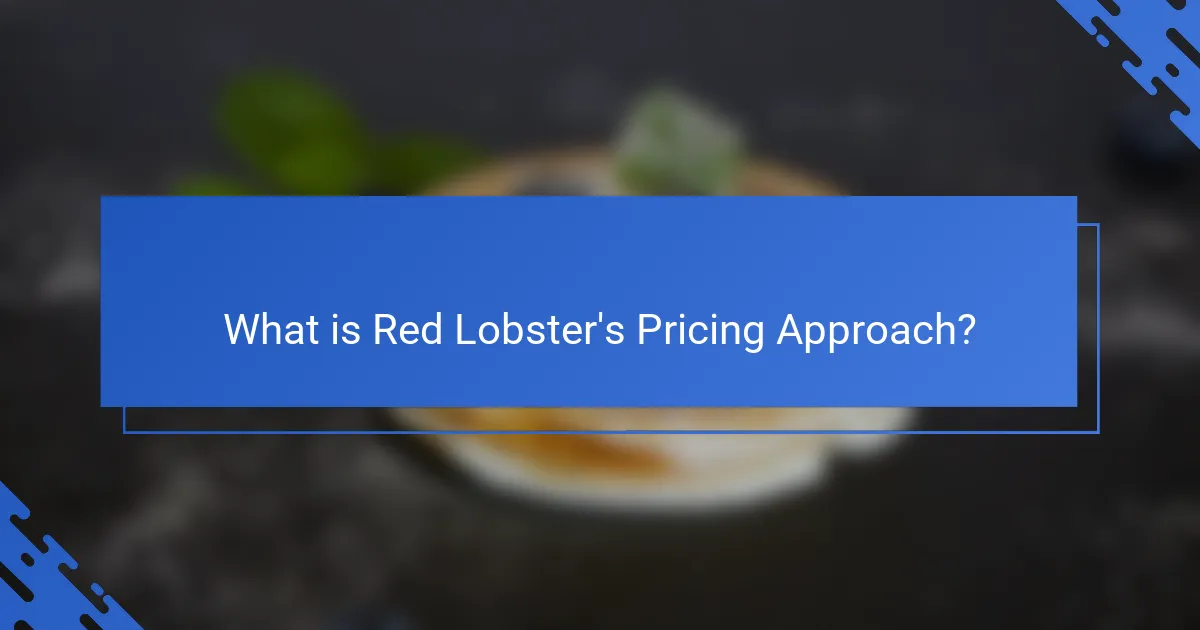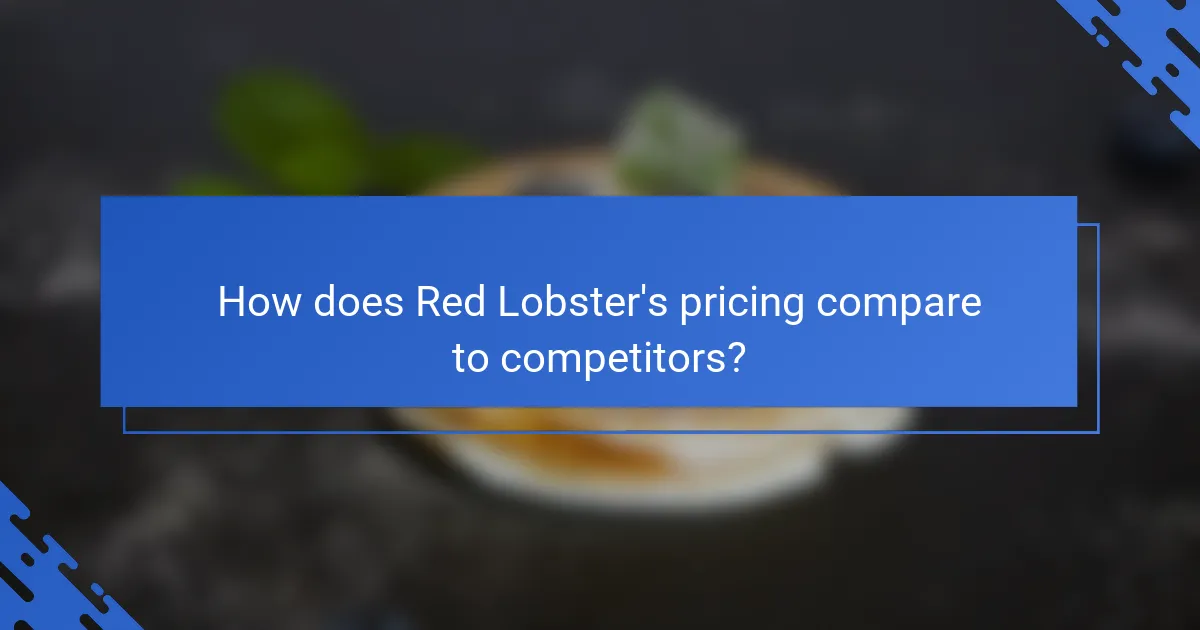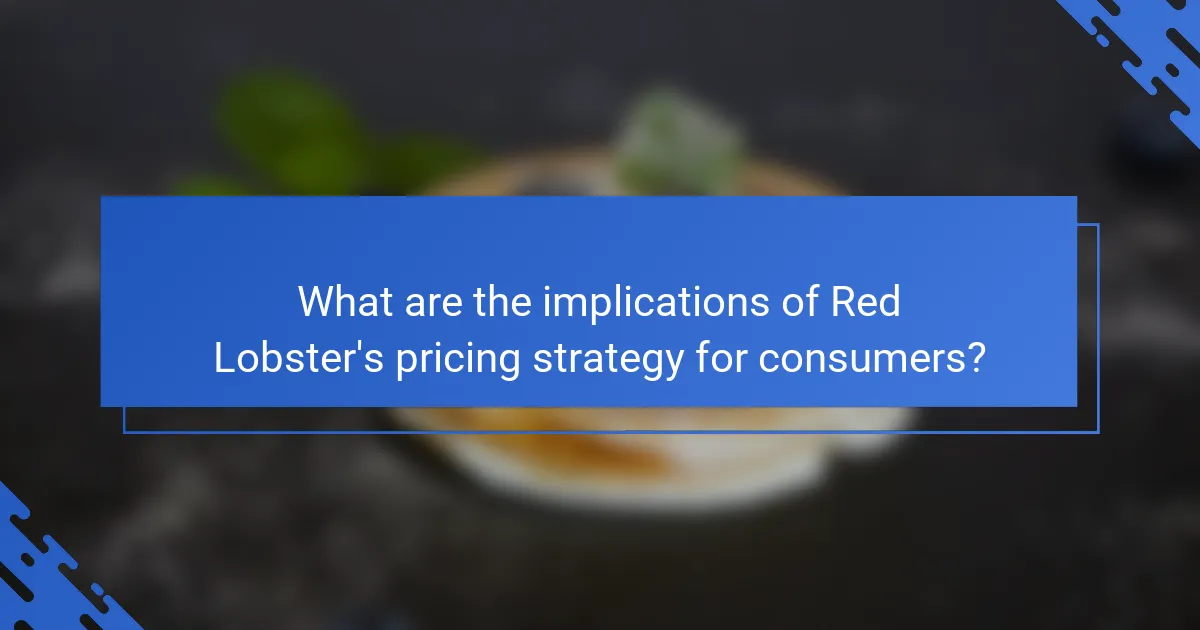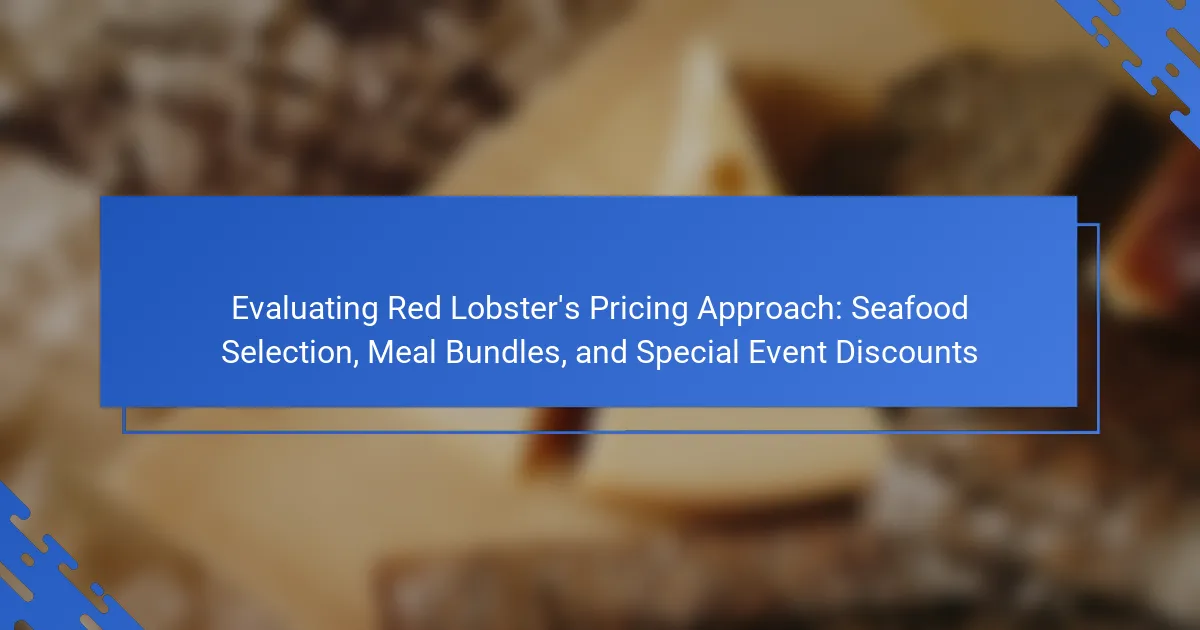Red Lobster is a casual dining restaurant specializing in seafood, known for its competitive pricing strategy that combines value-based pricing with meal bundles and seasonal promotions. The restaurant targets a diverse customer base by balancing quality and affordability, offering menu items typically priced between $15 and $30. Red Lobster emphasizes fresh ingredients and premium offerings, which may result in slightly higher prices compared to competitors. The pricing strategy aims to enhance customer satisfaction while ensuring profitability, influencing consumer choices and loyalty through perceived value and transparency.

What is Red Lobster’s Pricing Approach?
Red Lobster’s pricing approach focuses on offering a variety of seafood options at competitive prices. The restaurant employs a value-based pricing strategy. This strategy emphasizes meal bundles that provide customers with a perceived higher value for their money. Seasonal promotions and special event discounts also play a significant role in their pricing model. Red Lobster targets a broad customer base by balancing quality and affordability. The restaurant frequently updates its menu to reflect market trends and customer preferences. This adaptability helps maintain customer interest and loyalty. Overall, Red Lobster’s pricing approach is designed to enhance customer satisfaction while ensuring profitability.
How does Red Lobster determine its seafood pricing?
Red Lobster determines its seafood pricing based on market conditions and sourcing costs. The restaurant analyzes the supply and demand dynamics of various seafood types. Seasonal availability also influences pricing, as certain seafood may be more expensive at different times of the year. Additionally, Red Lobster considers sustainability practices when sourcing seafood. This ensures that prices reflect both ethical sourcing and quality. Historical pricing data and competitor analysis help inform their pricing strategy. The combination of these factors allows Red Lobster to set competitive prices while maintaining quality standards.
What factors influence the cost of seafood items at Red Lobster?
The cost of seafood items at Red Lobster is influenced by several factors. These include market prices of seafood, seasonal availability, and sourcing practices. Market prices fluctuate based on supply and demand dynamics. Seasonal availability affects the types of seafood offered and their pricing. Sourcing practices, such as sustainability and local sourcing, can also impact costs. Additionally, preparation methods and portion sizes contribute to the overall price. Economic conditions and competition in the seafood market further influence pricing strategies. These factors collectively determine the final cost of seafood items at Red Lobster.
How does market demand affect Red Lobster’s pricing strategy?
Market demand significantly influences Red Lobster’s pricing strategy. When demand for seafood increases, Red Lobster can raise prices to maximize revenue. Conversely, during low demand periods, the restaurant may lower prices to attract customers. Seasonal trends also affect demand, as certain seafood types become more popular at specific times of the year. For instance, demand typically spikes during holidays, prompting Red Lobster to offer special pricing or meal bundles. Additionally, competitive pricing is crucial; Red Lobster adjusts prices based on competitor offerings to maintain market share. Historical data shows that price adjustments correlate with fluctuations in customer traffic and sales volume. This dynamic pricing strategy helps optimize profits while responding to consumer preferences and market conditions.
What types of meal bundles does Red Lobster offer?
Red Lobster offers several types of meal bundles. These include the “Ultimate Feast,” which features a combination of lobster, shrimp, and crab. The “Seafood Feast” bundle includes various seafood options served with sides. Another option is the “Family Meal,” designed for sharing and featuring multiple entrees and sides. Red Lobster frequently updates its menu, so specific bundles may vary by location and season. Additionally, promotional bundles may be available for special occasions or holidays.
How do meal bundles provide value to customers?
Meal bundles provide value to customers by offering a combination of dishes at a lower price than purchasing items individually. This pricing strategy enhances perceived savings and encourages customers to try multiple menu options. For example, a meal bundle might include an appetizer, entrée, and dessert for a discounted rate. This not only simplifies decision-making but also enhances the dining experience by providing a comprehensive meal. According to industry studies, customers are more likely to choose bundled meals due to the convenience and perceived value. Bundles can also attract new customers who may be hesitant to try a full-priced meal. Overall, meal bundles create a win-win scenario by increasing customer satisfaction and driving sales for the restaurant.
What are the popular meal bundle options available at Red Lobster?
Red Lobster offers several popular meal bundle options. The “Ultimate Feast” includes a combination of lobster, shrimp, and crab. The “Lobster and Shrimp” bundle features grilled lobster and shrimp scampi. “Seafood Lover’s Duo” pairs shrimp and a choice of fish. The “Create Your Own Feast” allows customization with different seafood options. These meal bundles cater to various tastes and preferences. Each bundle provides a variety of seafood in one meal, enhancing the dining experience.
What special event discounts does Red Lobster provide?
Red Lobster provides special event discounts during certain holidays and occasions. These discounts often include promotions for events like Valentine’s Day, Mother’s Day, and National Lobster Day. For example, on National Lobster Day, guests may receive discounts on lobster dishes. Additionally, Red Lobster frequently offers limited-time promotions tied to seasonal events. These promotions are advertised through their website and email newsletters. Customers can also find discounts through loyalty programs and special offers for birthdays or anniversaries.
How can customers take advantage of special discounts during events?
Customers can take advantage of special discounts during events by subscribing to Red Lobster’s newsletter. This subscription often provides exclusive access to promotional offers. Customers can also follow Red Lobster on social media platforms for real-time updates on discounts. Participating in loyalty programs can yield additional savings during events. Checking the official website for seasonal promotions is another effective strategy. Many events feature limited-time offers that are advertised prominently online. Customers should plan their visits around these events to maximize savings. Research indicates that promotional events can result in discounts of up to 20% off regular menu prices.
What are the criteria for eligibility for these discounts?
Eligibility for discounts at Red Lobster typically requires customers to meet specific criteria. These may include being a member of the restaurant’s loyalty program. Customers might also need to present valid identification for special event discounts. Additionally, certain discounts may only apply to specific menu items or during designated times. Proof of eligibility often includes promotional codes or membership cards. Discounts may also be limited to certain locations or require prior reservations. Checking the official website or contacting the restaurant can provide exact eligibility details.

How does Red Lobster’s pricing compare to competitors?
Red Lobster’s pricing is generally competitive within the casual dining seafood sector. The restaurant typically offers a range of menu items priced between $15 and $30. This pricing structure aligns closely with competitors like Long John Silver’s and Bonefish Grill, which offer similar seafood options. However, Red Lobster’s prices can be slightly higher due to its emphasis on fresh ingredients and premium offerings. For example, a lobster tail dish at Red Lobster may cost around $25, while similar dishes at competitors can range from $20 to $25. Additionally, Red Lobster provides meal bundles and seasonal promotions, enhancing value compared to some competitors who may not offer such deals. Overall, Red Lobster’s pricing reflects its positioning as a slightly upscale seafood dining option.
What are the key differences in pricing strategies among seafood restaurants?
Seafood restaurants employ various pricing strategies that differentiate them in the market. One key difference is the menu pricing approach. Some restaurants use market-based pricing, aligning their prices with competitors. Others adopt value-based pricing, focusing on the perceived value of their seafood offerings.
Another difference is the use of dynamic pricing. Certain establishments adjust prices based on demand fluctuations, particularly during peak seasons. For example, prices may rise during holidays or weekends when seafood demand is higher.
Additionally, seafood restaurants may implement bundled pricing strategies. This involves offering meal combinations at a lower price than purchasing items separately. Such bundles can attract customers seeking value for money.
Promotional pricing is also prevalent among seafood restaurants. They may offer discounts or special deals to entice customers. For instance, happy hour discounts on appetizers or drinks can increase foot traffic during slower periods.
Lastly, some seafood restaurants focus on premium pricing. They position themselves as high-end dining experiences, justifying higher prices through quality and exclusivity. This strategy often appeals to customers willing to pay more for upscale dining.
How does Red Lobster’s seafood selection impact its pricing compared to others?
Red Lobster’s seafood selection significantly influences its pricing compared to competitors. The restaurant offers a diverse range of seafood options, including premium items like lobster and crab. This variety allows Red Lobster to cater to different customer preferences and price points.
Higher quality seafood typically comes at a premium cost due to sourcing and freshness requirements. Red Lobster emphasizes sustainability, which can also raise prices. The brand frequently promotes meal bundles that combine various seafood items, providing perceived value while maintaining higher price points.
In comparison, other seafood restaurants may offer limited selections or focus on less expensive options, affecting their overall pricing strategy. The combination of extensive seafood offerings and quality sourcing justifies Red Lobster’s pricing structure in the competitive landscape.
Why is customer feedback important in shaping Red Lobster’s pricing?
Customer feedback is crucial in shaping Red Lobster’s pricing. It helps the restaurant understand customer preferences and willingness to pay. By analyzing feedback, Red Lobster can adjust prices to match perceived value. This ensures that pricing aligns with customer expectations. For instance, if feedback indicates that a meal is seen as too expensive, Red Lobster may consider lowering the price or enhancing the meal’s value. Additionally, customer insights guide promotional strategies and discounts. This responsiveness to feedback fosters customer loyalty and satisfaction. Ultimately, customer feedback informs pricing decisions that can lead to increased sales and profitability.
How does customer satisfaction influence pricing adjustments?
Customer satisfaction directly influences pricing adjustments by impacting demand and perceived value. Higher satisfaction leads to increased customer loyalty and repeat business. When customers feel valued, they are often willing to pay higher prices. Studies show that a 5% increase in customer retention can lead to a 25% to 95% increase in profits. Conversely, low satisfaction can result in price reductions to attract new customers. Businesses often adjust prices based on feedback to enhance satisfaction levels. This dynamic relationship ensures that pricing strategies align with customer expectations and market conditions.

What are the implications of Red Lobster’s pricing strategy for consumers?
Red Lobster’s pricing strategy directly impacts consumers by influencing their dining choices and overall satisfaction. The pricing reflects the quality and variety of seafood offerings. Consumers may perceive higher prices as indicative of premium quality. Meal bundles provide perceived value, encouraging larger purchases. Special event discounts attract budget-conscious diners, enhancing foot traffic. Pricing transparency is crucial for building trust with consumers. Price fluctuations can affect consumer loyalty and repeat visits. Overall, the strategy aims to balance profitability with customer satisfaction.
How can consumers maximize their dining experience at Red Lobster?
To maximize their dining experience at Red Lobster, consumers should explore the seafood selection and meal bundles. Choosing fresh catch options enhances flavor and quality. Meal bundles often provide better value than ordering à la carte. Consumers can also benefit from special event discounts, which are frequently offered. Checking the website or app for promotions can lead to savings. Additionally, visiting during off-peak hours may reduce wait times. Engaging with staff for recommendations can enhance the meal experience. Finally, pairing meals with suitable beverages can complement flavors and elevate enjoyment.
What tips can help customers save money while enjoying meals at Red Lobster?
Customers can save money at Red Lobster by utilizing special promotions and meal bundles. Red Lobster frequently offers discounts on select menu items during specific days of the week. For example, the “Endless Shrimp” promotion allows customers to enjoy unlimited shrimp for a fixed price. Additionally, customers can take advantage of the “Lobsterfest” event, where lobster dishes are featured at reduced prices.
Joining the Red Lobster rewards program provides access to exclusive offers and birthday discounts. Customers should also consider sharing large platters or ordering from the lunch menu, which typically features lower prices. By checking the website for current deals and coupons, customers can further enhance their savings. These strategies help customers enjoy meals while keeping their expenses in check.
What should customers consider before dining at Red Lobster?
Customers should consider Red Lobster’s menu variety and pricing before dining. The restaurant specializes in seafood, offering a range of dishes from lobster to shrimp. Customers should also evaluate meal bundles, which provide value through combination offerings. Special event discounts may apply, enhancing affordability during certain occasions. Additionally, customers should review the restaurant’s location and operating hours. Understanding the dining atmosphere can also influence the experience. Lastly, checking online reviews can provide insights into service quality and food satisfaction.
Red Lobster’s pricing approach centers on providing a diverse range of seafood options at competitive prices, employing a value-based strategy that includes meal bundles and seasonal promotions. The article evaluates how Red Lobster determines seafood pricing based on market conditions, sourcing costs, and customer demand, while also exploring the factors influencing the cost of menu items. Additionally, it discusses the restaurant’s meal bundle offerings, special event discounts, and how customer feedback shapes pricing strategies. Overall, the content highlights the implications of Red Lobster’s pricing strategy for consumers and offers tips for maximizing their dining experience.
